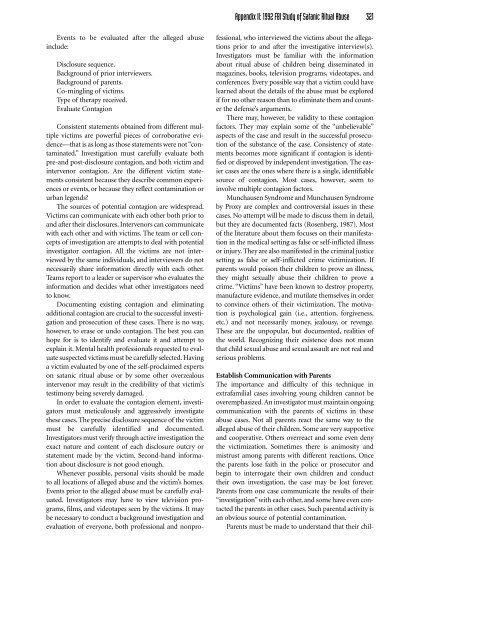Satanism Today - An Encyclopedia of Religion, Folklore and Popular ...
Satanism Today - An Encyclopedia of Religion, Folklore and Popular ...
Satanism Today - An Encyclopedia of Religion, Folklore and Popular ...
Create successful ePaper yourself
Turn your PDF publications into a flip-book with our unique Google optimized e-Paper software.
Appendix II: 1992 FBI Study <strong>of</strong> Satanic Ritual Abuse 321<br />
Events to be evaluated after the alleged abuse<br />
include:<br />
Disclosure sequence.<br />
Background <strong>of</strong> prior interviewers.<br />
Background <strong>of</strong> parents.<br />
Co-mingling <strong>of</strong> victims.<br />
Type <strong>of</strong> therapy received.<br />
Evaluate Contagion<br />
Consistent statements obtained from different multiple<br />
victims are powerful pieces <strong>of</strong> corroborative evidence—that<br />
is as long as those statements were not “contaminated.”<br />
Investigation must carefully evaluate both<br />
pre-<strong>and</strong> post-disclosure contagion, <strong>and</strong> both victim <strong>and</strong><br />
intervenor contagion. Are the different victim statements<br />
consistent because they describe common experiences<br />
or events, or because they reflect contamination or<br />
urban legends<br />
The sources <strong>of</strong> potential contagion are widespread.<br />
Victims can communicate with each other both prior to<br />
<strong>and</strong> after their disclosures. Intervenors can communicate<br />
with each other <strong>and</strong> with victims. The team or cell concepts<br />
<strong>of</strong> investigation are attempts to deal with potential<br />
investigator contagion. All the victims are not interviewed<br />
by the same individuals, <strong>and</strong> interviewers do not<br />
necessarily share information directly with each other.<br />
Teams report to a leader or supervisor who evaluates the<br />
information <strong>and</strong> decides what other investigators need<br />
to know.<br />
Documenting existing contagion <strong>and</strong> eliminating<br />
additional contagion are crucial to the successful investigation<br />
<strong>and</strong> prosecution <strong>of</strong> these cases. There is no way,<br />
however, to erase or undo contagion. The best you can<br />
hope for is to identify <strong>and</strong> evaluate it <strong>and</strong> attempt to<br />
explain it. Mental health pr<strong>of</strong>essionals requested to evaluate<br />
suspected victims must be carefully selected. Having<br />
a victim evaluated by one <strong>of</strong> the self-proclaimed experts<br />
on satanic ritual abuse or by some other overzealous<br />
intervenor may result in the credibility <strong>of</strong> that victim’s<br />
testimony being severely damaged.<br />
In order to evaluate the contagion element, investigators<br />
must meticulously <strong>and</strong> aggressively investigate<br />
these cases. The precise disclosure sequence <strong>of</strong> the victim<br />
must be carefully identified <strong>and</strong> documented.<br />
Investigators must verify through active investigation the<br />
exact nature <strong>and</strong> content <strong>of</strong> each disclosure outcry or<br />
statement made by the victim. Second-h<strong>and</strong> information<br />
about disclosure is not good enough.<br />
Whenever possible, personal visits should be made<br />
to all locations <strong>of</strong> alleged abuse <strong>and</strong> the victim’s homes.<br />
Events prior to the alleged abuse must be carefully evaluated.<br />
Investigators may have to view television programs,<br />
films, <strong>and</strong> videotapes seen by the victims. It may<br />
be necessary to conduct a background investigation <strong>and</strong><br />
evaluation <strong>of</strong> everyone, both pr<strong>of</strong>essional <strong>and</strong> nonpr<strong>of</strong>essional,<br />
who interviewed the victims about the allegations<br />
prior to <strong>and</strong> after the investigative interview(s).<br />
Investigators must be familiar with the information<br />
about ritual abuse <strong>of</strong> children being disseminated in<br />
magazines, books, television programs, videotapes, <strong>and</strong><br />
conferences. Every possible way that a victim could have<br />
learned about the details <strong>of</strong> the abuse must be explored<br />
if for no other reason than to eliminate them <strong>and</strong> counter<br />
the defense’s arguments.<br />
There may, however, be validity to these contagion<br />
factors. They may explain some <strong>of</strong> the “unbelievable”<br />
aspects <strong>of</strong> the case <strong>and</strong> result in the successful prosecution<br />
<strong>of</strong> the substance <strong>of</strong> the case. Consistency <strong>of</strong> statements<br />
becomes more significant if contagion is identified<br />
or disproved by independent investigation. The easier<br />
cases are the ones where there is a single, identifiable<br />
source <strong>of</strong> contagion. Most cases, however, seem to<br />
involve multiple contagion factors.<br />
Munchausen Syndrome <strong>and</strong> Munchausen Syndrome<br />
by Proxy are complex <strong>and</strong> controversial issues in these<br />
cases. No attempt will be made to discuss them in detail,<br />
but they are documented facts (Rosenberg, 1987). Most<br />
<strong>of</strong> the literature about them focuses on their manifestation<br />
in the medical setting as false or self-inflicted illness<br />
or injury. They are also manifested in the criminal justice<br />
setting as false or self-inflicted crime victimization. If<br />
parents would poison their children to prove an illness,<br />
they might sexually abuse their children to prove a<br />
crime. “Victims” have been known to destroy property,<br />
manufacture evidence, <strong>and</strong> mutilate themselves in order<br />
to convince others <strong>of</strong> their victimization. The motivation<br />
is psychological gain (i.e., attention, forgiveness,<br />
etc.) <strong>and</strong> not necessarily money, jealousy, or revenge.<br />
These are the unpopular, but documented, realities <strong>of</strong><br />
the world. Recognizing their existence does not mean<br />
that child sexual abuse <strong>and</strong> sexual assault are not real <strong>and</strong><br />
serious problems.<br />
Establish Communication with Parents<br />
The importance <strong>and</strong> difficulty <strong>of</strong> this technique in<br />
extrafamilial cases involving young children cannot be<br />
overemphasized. <strong>An</strong> investigator must maintain ongoing<br />
communication with the parents <strong>of</strong> victims in these<br />
abuse cases. Not all parents react the same way to the<br />
alleged abuse <strong>of</strong> their children. Some are very supportive<br />
<strong>and</strong> cooperative. Others overreact <strong>and</strong> some even deny<br />
the victimization. Sometimes there is animosity <strong>and</strong><br />
mistrust among parents with different reactions. Once<br />
the parents lose faith in the police or prosecutor <strong>and</strong><br />
begin to interrogate their own children <strong>and</strong> conduct<br />
their own investigation, the case may be lost forever.<br />
Parents from one case communicate the results <strong>of</strong> their<br />
“investigation” with each other, <strong>and</strong> some have even contacted<br />
the parents in other cases. Such parental activity is<br />
an obvious source <strong>of</strong> potential contamination.<br />
Parents must be made to underst<strong>and</strong> that their chil-
















